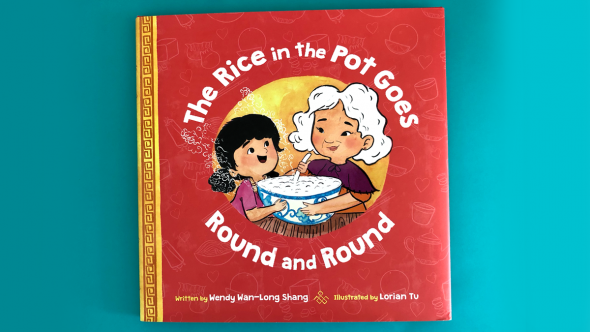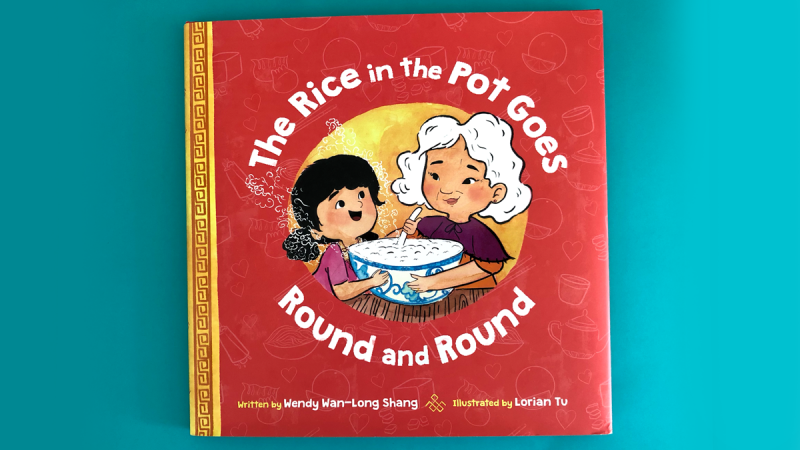You may have heard of the wheels on the bus going round and round, but what about the rice in the pot?
In the charming new picture book The Rice in the Pot Goes Round and Round by Wendy Wan-Long Shang with illustrations by Lorian Tu, a Chinese-American family gathers at the table where they share food, laughter, and love, all to the tune of a classic sing along.
See below for an interview between Wendy and Lorian! You can also find a fun activity to print out and complete as a family.

Lorian Tu: I can't think of anything better than sharing a meal with my loved ones. What are some of your favorite memories of eating with family and friends? Do you have a favorite dish?
Wendy Wan-Long Shang: A couple of years ago, we had a family reunion at the beach, and one night we all got together and made a huuuuge batch of dumplings for dinner. It’s my favorite memory of the whole trip. There’s something magical that happens when your hands get busy and your group is working toward a common goal (in this case, dinner!). You have these conversations that you might not otherwise have. We’re planning another family reunion (just to be clear—a long time from now), and I’ve already staked out a claim for another dumpling night. Another tradition is huo guo, or hot pot, on my birthday at my mom’s house. We start off cooking thinly sliced meats in a central pot of hot water, and then at the end we add noodles and vegetables to the water, now turned into a broth by having meat cooked in it, and have a soup. No one is hungry after huo guo! (Though we do manage to fit in a birthday cake!)
LT: And speaking of food, do you like to cook? What kinds of things do you most enjoy cooking or baking?
WS: I prefer baking to cooking, just because I associate baking with special occasions, away from the daily demand of making dinner. Cooking is about sustenance, but baking is about love. I love making Swiss lemon twist bread because it’s a contemplative process with kneading, waiting and braiding, and the result is so pretty and delicious. I also enjoy taking some overripe bananas and making a quick bread out of them. It makes a nice mid-week surprise for snacks. I have two active teens living at home right now—nothing lasts long in this house!
LT: In addition to this picture book, I know you've written a few middle grade books! What is your writing routine like? Do stories just pop into your head, or do you work on a story for a long, long time?
WS: The Rice in the Pot Goes Round and Round is my first picture book, and the idea for that book popped into my head on a long drive home one Thanksgiving. Most of my books are middle grade, though, which is a much longer process. When I’m really in the groove, I tend to write in 1-2 hours spurts, a couple times throughout the day. The trick for me is using my downtime to generate ideas and approaches for the next section, so that by the time I get back to the screen, I’m ready to roll instead of just staring at a blinking cursor. I tend to get started by a single idea, and then build out a world from there. As a general rule I write slowly, but I had a couple of short deadlines in 2020 and I learned a lot about drafting fast and rewriting hard.

WS: You had a whole family to illustrate! Did you draw upon any members of your own family for inspiration?
LT: Very much so, yes! I used my grandfather and his mother to develop the grandparents, an amalgamation of my father and my brother for the dad, my aunt for the older sister, and my niece for the younger sister. Because I have a mixed family (we are Chinese and Cuban, and on my mother's side, white) I did use my father, aunt, brother, and niece as more of a jumping-off point than an actual copy, but I tried to stay pretty true to my own ye ye and his mother, who are both Chinese.
WS: I love the fullness of your illustrations—the rich colors and how the illustrations take up the whole spread! What comes to you first when you illustrate? Colors? Expression? Composition?
LT: I always begin with emotion. I feel that is the essence and the bottom line of art, especially when it's art for children. To me, there is no point in creating a realistic copy of anything if there is no emotion in it, and so I try to prioritize emotion over all else first. I draw from my own lived memories and experiences, and from my experience as a former theatre major too! While sketching, I'll often use a mirror or take a photo of myself to get facial expressions the way I want them. After I have the rough sketch, the challenge is to incorporate things like composition, how the pictures and text support each other, and other narrative details. I'm extremely grateful to my art directors for keeping me in line during this more technical phase! When coloring, I like to let my brush play with the water and paint and keep things as loose and child-like as possible. It's incredibly therapeutic.
WS: Was there a moment for you when you realized that you could be a professional artist? Was there a teacher who encouraged you or a contest that motivated you? What advice do you have for aspiring illustrators?
LT: My grandfather was an engineer, and I grew up in my grandparents' house. His home office was always filled with blueprints, mechanical pencils, special rulers, and all sorts of interesting drafting equipment. He and I would spend a lot of time drawing together, him making mostly buildings, and me making animals and people to fill them with. I never thought I'd make a career out of it, but I did become an art teacher, which was wonderful. My favorite thing in the world is to make art with children, and see what comes out of their beautiful minds.
I turned to illustration as a professional career when I had my own children, and needed to take a step back from working in the classroom. I'm so grateful that I've had so many opportunities to work with the amazing authors, editors, and art directors that I have worked with, and more so, I'm honored to be able to be a part of children's reading lives because picture books were such a huge part of my life growing up... I guess they still are!
My advice for anyone wanting to illustrate books is to read, read, read, and draw, draw, draw. Learn from your mistakes and keep going. If there is something you want to do, keep fighting for it no matter how hard it seems or how long it takes. Your time will come.
More about Wendy Wan-Long Shang:
Wendy Wan-Long Shang is the author of The Great Wall of Lucy Wu, which was awarded the Asian/Pacific American Award for Children's Literature; The Way Home Looks Now, an Amelia Bloomer Project List selection and a CCBC Choices List selection; and This Is Just a Test, which she co-wrote with Madelyn Rosenberg and which is a Sydney Taylor Honor Book. She lives with her family in the suburbs of Washington, DC.
More about Lorian Tu:
Lorian Tu is a former art and special education teacher for elementary school kids, and currently a full-time maker of kid-lit and kid-lit-art. A mom and an art teacher, her greatest inspiration comes from her sons and her students, as well as from her mixed-race, multi-ethnic childhood and adult life. She is the illustrator of Dress Like a Girl, written by Patricia Toht; May God Bless You and Keep You, written by Sarah Raymond Cunningham; and Stay Through the Storm, written by Joanna Rowland.




